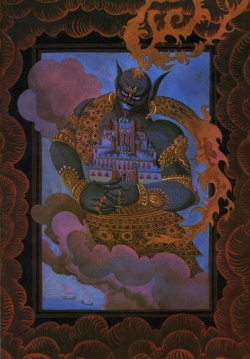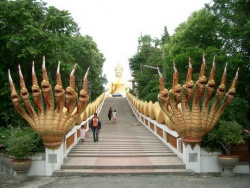Difference between revisions of "Flower Garland school"
| Line 1: | Line 1: | ||
| + | <nomobile>{{DisplayImages|2965|2654}}</nomobile> | ||
| + | |||
| + | |||
| + | |||
| Line 18: | Line 22: | ||
The [[Flower Garland school]] was introduced to [[Japan]] by [[Tao-hsüan]] (702-760), a [[priest]] from [[China]], in 736. | The [[Flower Garland school]] was introduced to [[Japan]] by [[Tao-hsüan]] (702-760), a [[priest]] from [[China]], in 736. | ||
| − | In 740 Shinjo(Kor Sim-sang), a [[priest]] from [[Silla]] on the {{Wiki|Korean Peninsula}}, who had studied under [[Fa-tsang]], lectured on the [[Flower Garland Sutra]] in [[Japan]]. | + | In 740 [[Shinjo]]([[Kor Sim-sang]]), a [[priest]] from [[Silla]] on the {{Wiki|Korean Peninsula}}, who had studied under [[Fa-tsang]], lectured on the [[Flower Garland Sutra]] in [[Japan]]. |
| − | He is regarded as the founder of the [[Japanese]] [[Flower Garland school]]. [[Todai-ji]] in Nara is the head [[temple]] of the school. | + | He is regarded as the founder of the [[Japanese]] [[Flower Garland school]]. [[Todai-ji]] in [[Nara]] is the head [[temple]] of the school. |
The [[Flower Garland school]] teaches that all [[phenomena]] interpenetrate without obstruction; one permeates all and all are contained in one. | The [[Flower Garland school]] teaches that all [[phenomena]] interpenetrate without obstruction; one permeates all and all are contained in one. | ||
| − | Unlike the [[Tendai school]], which elucidates the relationship between [[phenomena]] and the [[ultimate reality]], the [[Flower Garland school]] is primarily concerned with the relationships among [[phenomena]]. | + | Unlike the [[Tendai school]], which elucidates the relationship between [[phenomena]] and the [[ultimate reality]], the [[Flower Garland school]] is primarily concerned with the relationships among [[phenomena]]. |
| − | |||
| − | |||
| + | See also six [[forms]]; [[ten mysteries]]. | ||
see also: [[Hua-yen school]] | see also: [[Hua-yen school]] | ||
| + | {{R}} | ||
| + | http://www.sgilibrary.org/search_dict.php | ||
| + | [[Category:Hua-yen school]] | ||
Revision as of 20:02, 3 January 2016
Flower Garland school 華厳宗 (Chin Hua-yen-tsung; Jpn Kegon-shu)
A school based on the Flower Garland Sutra. Tu-shun (557-640) is usually regarded as the founder of the Flower Garland school in China.
His successor was Chih-yen. Chih-yen's disciple Fa-tsang (also known as the Great Teacher Hsien-shou) systematized the doctrines of the school.
Hence the Flower Garland school is also called the Hsien-shou (Jpn Genju) school.
Fa-tsang was followed by Ch'eng-kuan, who was in turn succeeded by his disciple Tsung-mi. These five persons are regarded as the first five patriarchs of the Chinese Flower Garland school.
Fa-tsang, the third patriarch, formulated a classification of the Buddhist teachings called the "five teachings and ten doctrines" to show the superiority of the Flower Garland Sutra over all the other sutras.
His system arranged the Buddhist sutras into five categories according to their degree of profundity, and the Buddhist schools into ten categories according to their doctrines.
The Flower Garland school was introduced to Japan by Tao-hsüan (702-760), a priest from China, in 736.
In 740 Shinjo(Kor Sim-sang), a priest from Silla on the Korean Peninsula, who had studied under Fa-tsang, lectured on the Flower Garland Sutra in Japan.
He is regarded as the founder of the Japanese Flower Garland school. Todai-ji in Nara is the head temple of the school.
The Flower Garland school teaches that all phenomena interpenetrate without obstruction; one permeates all and all are contained in one.
Unlike the Tendai school, which elucidates the relationship between phenomena and the ultimate reality, the Flower Garland school is primarily concerned with the relationships among phenomena.
See also six forms; ten mysteries.
see also: Hua-yen school

